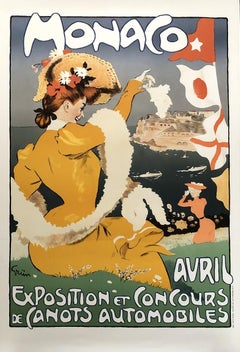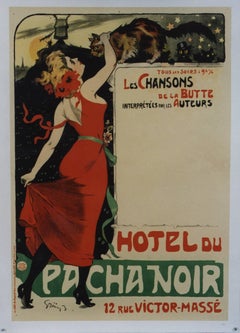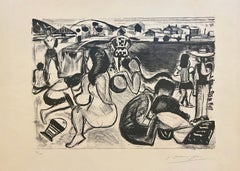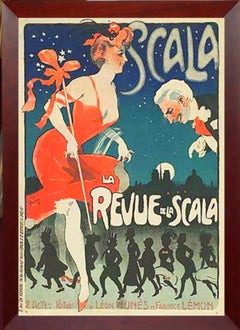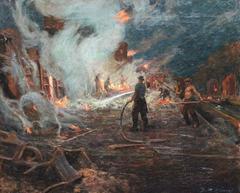Jules-Alexandre Grün Art
to
1
1
1
Overall Width
to
Overall Height
to
2
1
2
2
2
2
2
1
1
1
2
2
9,422
2,689
1,374
1,355
1
1
Artist: Jules-Alexandre Grün
Monaco Exposition And Concours Automobiles - Lithographic Poster Signed
By Jules-Alexandre Grün
Located in Paris, IDF
Jules-Alexandre GRUN
Monaco, exposition and concours automobiles
Lithographic poster
Signed in the plate
Printed by Arte Paris and published by Maeght
Size 98 x 65 cm (c. 38.6 x 25....
Category
20th Century Jules-Alexandre Grün Art
Materials
Lithograph
Hotel du Pacha Noir (before lettering).
By Jules-Alexandre Grün
Located in New York, NY
Hotel Pachenoir, 1900. Color lithograph. On Linen 51 x36. ( Image Size: 48 x33 3/4.)
Jules-Alexandre Grünwas a French post-impressionist painter, poster artist, and illustrator. ......
Category
Early 1900s Art Nouveau Jules-Alexandre Grün Art
Materials
Lithograph
Related Items
Untitled abstract seaside, original lithograph
By François Desnoyer
Located in Belgrade, MT
Pencil signed black and white lithograph original limited edition pencil signed , Guilde De La Gravure. Mid 20th Century, part of my private collection. Very Good condition.
Category
Mid-20th Century Cubist Jules-Alexandre Grün Art
Materials
Lithograph
$636 Sale Price
33% Off
H 13 in W 15 in
Clemente Untitled B: surreal mythical landscape, voyage with ocean, Venus, snake
By Francesco Clemente
Located in New York, NY
A black and white, large-scale surreal mythical landscape of an ocean voyage, with a snake wrapped around a clock, a ship, Venus sculpture, greek urns, and snakes, printed in black o...
Category
1980s Contemporary Jules-Alexandre Grün Art
Materials
Lithograph
$2,975
H 26.75 in W 119.25 in
19th century color lithograph figures cemetery willow tree memorial headstone
By Nathaniel Currier
Located in Milwaukee, WI
The present hand-colored lithograph was produced as part of the funeral and mourning culture in the United States during the 19th century. Images like this were popular as ways of remembering loved ones, an alternative to portraiture of the deceased. This lithograph shows a man, woman and child in morning clothes next to an urn-topped stone monument. Behind are additional putto-topped headstones beneath weeping willows, with a steepled church beyond. The monument contains a space where a family could inscribe the name and death dates of a deceased loved one. In this case, it has been inscribed to a young Civil War soldier:
William W. Peabody
Died at Fairfax Seminary, VA
December 18th, 1864
Aged 18 years
The young Mr. Peabody probably died in service for the Union during the American Civil War. Farifax Seminary was a Union hospital and military headquarters in Alexandria, Virginia. The hospital served nearly two thousand soldiers during the war time. Five hundred were also buried on the Seminary's grounds.
13.75 x 9.5 inches, artwork
23 x 19 inches, frame
Published before 1864
Inscribed bottom center "Lith. & Pub. by N. Currier. 2 Spruce St. N.Y."
Framed to conservation standards using 100 percent rag matting and TruVue Conservation Clear glass, housed in a gold gilded moulding.
Nathaniel Currier was a tall introspective man with a melancholy nature. He could captivate people with his piercing stare or charm them with his sparkling blue eyes. Nathaniel was born in Roxbury, Massachusetts on March 27th, 1813, the second of four children. His parents, Nathaniel and Hannah Currier, were distant cousins who lived a humble yet spartan life. When Nathaniel was eight years old, tragedy struck. Nathaniel’s father unexpectedly passed away leaving Nathaniel and his eleven-year-old brother Lorenzo to provide for the family. In addition to their mother, Nathaniel and Lorenzo had to care for six-year-old sister Elizabeth and two-year-old brother Charles. Nathaniel worked a series of odd jobs to support the family, and at fifteen, he started what would become a life-long career when he apprenticed in the Boston lithography shop of William and John Pendleton.
A Bavarian gentleman named Alois Senefelder invented lithography just 30 years prior to young Nat Currier’s apprenticeship. While under the employ of the brothers Pendleton, Nat was taught the art of lithography by the firm’s chief printer, a French national named Dubois, who brought the lithography trade to America.
Lithography involves grinding a piece of limestone flat and smooth then drawing in mirror image on the stone with a special grease pencil. After the image is completed, the stone is etched with a solution of aqua fortis leaving the greased areas in slight relief. Water is then used to wet the stone and greased-ink is rolled onto the raised areas. Since grease and water do not mix, the greased-ink is repelled by the moisture on the stone and clings to the original grease pencil lines. The stone is then placed in a press and used as a printing block to impart black on white images to paper.
In 1833, now twenty-years old and an accomplished lithographer, Nat Currier left Boston and moved to Philadelphia to do contract work for M.E.D. Brown, a noted engraver and printer. With the promise of good money, Currier hired on to help Brown prepare lithographic stones of scientific images for the American Journal of Sciences and Arts. When Nat completed the contract work in 1834, he traveled to New York City to work once again for his mentor John Pendleton, who was now operating his own shop located at 137 Broadway. Soon after the reunion, Pendleton expressed an interest in returning to Boston and offered to sell his print shop to Currier. Young Nat did not have the financial resources to buy the shop, but being the resourceful type he found another local printer by the name of Stodart. Together they bought Pendleton’s business.
The firm ‘Currier & Stodart’ specialized in "job" printing. They produced many different types of printed items, most notably music manuscripts for local publishers. By 1835, Stodart was frustrated that the business was not making enough money and he ended the partnership, taking his investment with him. With little more than some lithographic stones, and a talent for his trade, twenty-two year old Nat Currier set up shop in a temporary office at 1 Wall Street in New York City. He named his new enterprise ‘N. Currier, Lithographer’
Nathaniel continued as a job printer and duplicated everything from music sheets to architectural plans. He experimented with portraits, disaster scenes and memorial prints, and any thing that he could sell to the public from tables in front of his shop. During 1835 he produced a disaster print Ruins of the Planter's Hotel, New Orleans, which fell at two O’clock on the Morning of the 15th of May 1835, burying 50 persons, 40 of whom Escaped with their Lives. The public had a thirst for newsworthy events, and newspapers of the day did not include pictures. By producing this print, Nat gave the public a new way to “see” the news. The print sold reasonably well, an important fact that was not lost on Currier.
Nat met and married Eliza Farnsworth in 1840. He also produced a print that same year titled Awful Conflagration of the Steamboat Lexington in Long Island Sound on Monday Evening, January 18, 1840, by which melancholy occurrence over One Hundred Persons Perished. This print sold out very quickly, and Currier was approached by an enterprising publication who contracted him to print a single sheet addition of their paper, the New York Sun. This single page paper is presumed to be the first illustrated newspaper ever published.
The success of the Lexington print launched his career nationally and put him in a position to finally lift his family up. In 1841, Nat and Eliza had their first child, a son they named Edward West Currier. That same year Nat hired his twenty-one year old brother Charles and taught him the lithography trade, he also hired his artistically inclined brother Lorenzo to travel out west and make sketches of the new frontier as material for future prints. Charles worked for the firm on and off over the years, and invented a new type of lithographic crayon which he patented and named the Crayola. Lorenzo continued selling sketches to Nat for the next few years.
In 1843, Nat and Eliza had a daughter, Eliza West Currier, but tragedy struck in early 1847 when their young daughter died from a prolonged illness. Nat and Eliza were grief stricken, and Eliza, driven by despair, gave up on life and passed away just four months after her daughter’s death.
The subject of Nat Currier’s artwork changed following the death of his wife and daughter, and he produced many memorial prints and sentimental prints during the late 1840s. The memorial prints generally depicted grief stricken families posed by gravestones (the stones were left blank so the purchasers could fill in the names of the dearly departed). The sentimental prints usually depicted idealized portraits of women and children, titled with popular Christian names of the day.
Late in 1847, Nat Currier married Lura Ormsbee, a friend of the family. Lura was a self-sufficient woman, and she immediately set out to help Nat raise six-year-old Edward and get their house in order. In 1849, Lura delivered a son, Walter Black Currier, but fate dealt them a blow when young Walter died one year later. While Nat and Lura were grieving the loss of their new son, word came from San Francisco that Nat’s brother Lorenzo had also passed away from a brief illness. Nat sank deeper into his natural quiet melancholy. Friends stopped by to console the couple, and Lura began to set an extra place at their table for these unexpected guests. She continued this tradition throughout their lives.
In 1852, Charles introduced a friend, James Merritt Ives, to Nat and suggested he hire him as a bookkeeper. Jim Ives was a native New Yorker born in 1824 and raised on the grounds of Bellevue Hospital where his father was employed as superintendent. Jim was a self-trained artist and professional bookkeeper. He was also a plump and jovial man, presenting the exact opposite image of his new boss.
Jim Ives met Charles Currier through Caroline Clark, the object of Jim’s affection. Caroline’s sister Elizabeth was married to Charles, and Caroline was a close friend of the Currier family. Jim eventually proposed marriage to Caroline and solicited an introduction to Nat Currier, through Charles, in hopes of securing a more stable income to support his future wife.
Ives quickly set out to improve and modernize his new employer’s bookkeeping methods. He reorganized the firm’s sizable inventory, and used his artistic skills to streamline the firm’s production methods. By 1857, Nathaniel had become so dependent on Jims’ skills and initiative that he offered him a full partnership in the firm and appointed him general manager. The two men chose the name ‘Currier & Ives’ for the new partnership, and became close friends.
Currier & Ives produced their prints in a building at 33 Spruce Street where they occupied the third, fourth and fifth floors. The third floor was devoted to the hand operated printing presses that were built by Nat's cousin, Cyrus Currier, at his shop Cyrus Currier & Sons in Newark, NJ. The fourth floor found the artists, lithographers and the stone grinders at work. The fifth floor housed the coloring department, and was one of the earliest production lines in the country. The colorists were generally immigrant girls, mostly German, who came to America with some formal artistic training. Each colorist was responsible for adding a single color to a print. As a colorist finished applying their color, the print was passed down the line to the next colorist to add their color. The colorists worked from a master print displayed above their table, which showed where the proper colors were to be placed. At the end of the table was a touch up artist who checked the prints for quality, touching-in areas that may have been missed as it passed down the line. During the Civil War, demand for prints became so great that coloring stencils were developed to speed up production.
Although most Currier & Ives prints were colored in house, some were sent out to contract artists. The rate Currier & Ives paid these artists for coloring work was one dollar per one hundred small folios (a penny a print) and one dollar per one dozen large folios. Currier & Ives also offered uncolored prints to dealers, with instructions (included on the price list) on how to 'prepare the prints for coloring.' In addition, schools could order uncolored prints from the firm’s catalogue to use in their painting classes.
Nathaniel Currier and James Merritt Ives attracted a wide circle of friends during their years in business. Some of their more famous acquaintances included Horace Greeley, Phineas T. Barnum, and the outspoken abolitionists Rev. Henry Ward, and John Greenleaf Whittier (the latter being a cousin of Mr. Currier).
Nat Currier and Jim Ives described their business as "Publishers of Cheap and Popular Pictures" and produced many categories of prints. These included Disaster Scenes, Sentimental Images, Sports, Humor, Hunting Scenes, Politics, Religion, City and Rural Scenes, Trains, Ships, Fire Fighters, Famous Race Horses, Historical Portraits, and just about any other topic that satisfied the general public's taste. In all, the firm produced in excess of 7500 different titles, totaling over one million prints produced from 1835 to 1907.
Nat Currier retired in 1880, and signed over his share of the firm to his son Edward. Nat died eight years later at his summer home 'Lion’s Gate' in Amesbury, Massachusetts. Jim Ives remained active in the firm until his death in 1895, when his share of the firm passed to his eldest son, Chauncey.
In 1902, faced will failing health from the ravages of Tuberculosis, Edward Currier sold his share of the firm to Chauncey Ives...
Category
Mid-19th Century Romantic Jules-Alexandre Grün Art
Materials
Watercolor, Lithograph
Original "Saxoleine Petrole Surete" vintage stone lithograph 1900
By Jules Chéret
Located in Spokane, WA
Original Saxoleine Petrole de Surete, artist Jules Cheret.
Linen-backed turn-of-the-century original stone lithograph poster advertising Saxoleine, a lamp oil. The glow from this l...
Category
Early 1900s Art Nouveau Jules-Alexandre Grün Art
Materials
Lithograph
$3,519 Sale Price
20% Off
H 49.25 in W 24.75 in D 0.05 in
Gerona Cathedral urbanscape lithograph
By Josep Moscardo
Located in Sitges, Barcelona
Josep Moscardó (1953) - Girona Cathedral
Lithograph - Hand signed
Lithograph measures 74x52 cm.
Frameless.
Numbered 121/150
Barcelona, 1953
Painter, s...
Category
1990s Post-Impressionist Jules-Alexandre Grün Art
Materials
Lithograph
$201 Sale Price
43% Off
H 29.14 in W 20.48 in
Lierre
By (after) Henri Matisse
Located in Washington, DC
Artist: Henri Matisse (after)
Medium: Original lithograph
Title: Lierre
Portfolio: The Last Works of Henri Matisse
Year: 1958
Edition: 2000
Framed Size: 17" x 17"
Sheet Size: 14" x 1...
Category
1950s Fauvist Jules-Alexandre Grün Art
Materials
Lithograph
"Le Passant, " Original Color Lithograph
By Robert Engels
Located in Milwaukee, WI
"Le Passant" is an original Art Nouveau color lithograph. It depicts two women in the foreground wearing medieval white robes and a knight passing behind them on a black horse. Features the L'Estampe Moderne blindstamp bottom right hand corner. 1898.
15 3/4" x 12" art
23" x 19 1/4" framed
Robert Engels studied in Dusseldorf and moved shortly thereafter to work in Munich. Later, he became a professor at a school of applied arts at the KGS in Munich. He created many decorative prints as well as stained glass windows and also created compositions to illustrate Joseph Bedier's rendition of "Tristan and Iseult...
Category
1890s Art Nouveau Jules-Alexandre Grün Art
Materials
Lithograph
Henri Matisse (after) La Tristesse du Roi (The Sadness of the King)
By (after) Henri Matisse
Located in Washington, DC
Artist: Henri Matisse (after)
Title: La Tristesse du Roi (The Sadness of the King)
Portfolio: The Last Works of Henri Matisse
Medium: Lithograph
Year: 1958
Edition: 2000
Frame Size: ...
Category
1950s Fauvist Jules-Alexandre Grün Art
Materials
Lithograph
$1,395
H 21.25 in W 26 in
L'escargot
By (after) Henri Matisse
Located in Washington, DC
Artist: Henri Matisse (after)
Title: L'escargot
Portfolio: The Last Works of Henri Matisse
Medium: Lithograph
Year: 1958
Edition: 2000
Framed Size: 17" x 17"
Sheet Size: 14" x 10 1/2...
Category
1950s Fauvist Jules-Alexandre Grün Art
Materials
Lithograph
Vision of Paris, Lithograph from Mourlot Lithographe I
By Marc Chagall
Located in Washington, DC
Artist: Marc Chagall
Title: Vision of Paris
Portfolio: Mourlot Lithographe I
Medium: Lithograph
Year: 1960
Edition: Unnumbered
Framed Size: 22" x 19"
Image Size: 12 1/2" x 9 1/2"
Sh...
Category
1960s Fauvist Jules-Alexandre Grün Art
Materials
Lithograph
Original Grece (Greece) vintage Greek Tourist Board vintage travel poster
Located in Spokane, WA
Original 1963 Greece Vintage Travel Poster – Greek National Tourist Board – Linen Backed, Grade A-
Bring home a piece of mid-century Mediterranean charm with this striking original 1963 Greece vintage travel poster, commissioned by the Greek National Tourist Board. This authentic The artifact captures the sun-drenched beauty of the Greek isles and the enduring charm of traditional Greek seafaring life.
This rare poster showcases a beautifully detailed illustration of a classic Greek boat, known as a kaiki (or caique)—a traditional wooden vessel that has sailed the Aegean and Ionian Seas for generations. Featuring its rounded hull, vibrant colors, and billowing sail, the kaiki was a staple of Greek fishing and local trade, embodying the spirit of the archipelago’s maritime culture.
Collector Features:
• Genuine vintage, not a reproduction
• Superb display condition; colors remain vivid and fresh
• Linen backing ensures durability and preserves value
• A rare example of Greek mid...
Category
1960s Abstract Jules-Alexandre Grün Art
Materials
Lithograph
$795
H 39 in W 27 in D 0.3 in
Late 19th century color lithograph art nouveau owl border woman figure
By Alphonse Mucha
Located in Milwaukee, WI
"From: Ilsée, Princesse de Tripoli Recto: "Blaye Castle" Verso: "Reflecting Pool" is an original color lithograph by Alphonse Mucha. Exquisite double-s...
Category
1890s Art Nouveau Jules-Alexandre Grün Art
Materials
Lithograph
$8,775
H 20.37 in W 18 in
Previously Available Items
Le Revue de la Scala
By Jules-Alexandre Grün
Located in Missouri, MO
Le Revue de la Scala By. Jules Alexandre Grun
With Frame: 35.5" x 27.5"
Without Frame: 31.5" x 23.5"
Jules Grun, once a student of Jean Baptiste ...
Category
Early 20th Century Art Nouveau Jules-Alexandre Grün Art
Materials
Lithograph
The Couronnes Disaster 1903
By Jules-Alexandre Grün
Located in Marlow, Buckinghamshire
An excellent and graphic interpretation of the famous Couronnes disaster from 1903 painted oil on canvas signed lower right.
The disastrous Paris Métro train fire occurred on the...
Category
Early 1900s Impressionist Jules-Alexandre Grün Art
Materials
Canvas, Oil
Jules-alexandre Grün art for sale on 1stDibs.
Find a wide variety of authentic Jules-Alexandre Grün art available for sale on 1stDibs. You can also browse by medium to find art by Jules-Alexandre Grün in lithograph and more. Not every interior allows for large Jules-Alexandre Grün art, so small editions measuring 26 inches across are available. Customers who are interested in this artist might also find the work of Paul Iribe, Georges Meunier, and Adolfo Hohenstein. Jules-Alexandre Grün art prices can differ depending upon medium, time period and other attributes. On 1stDibs, the price for these items starts at $323 and tops out at $2,800, while the average work can sell for $1,562.
